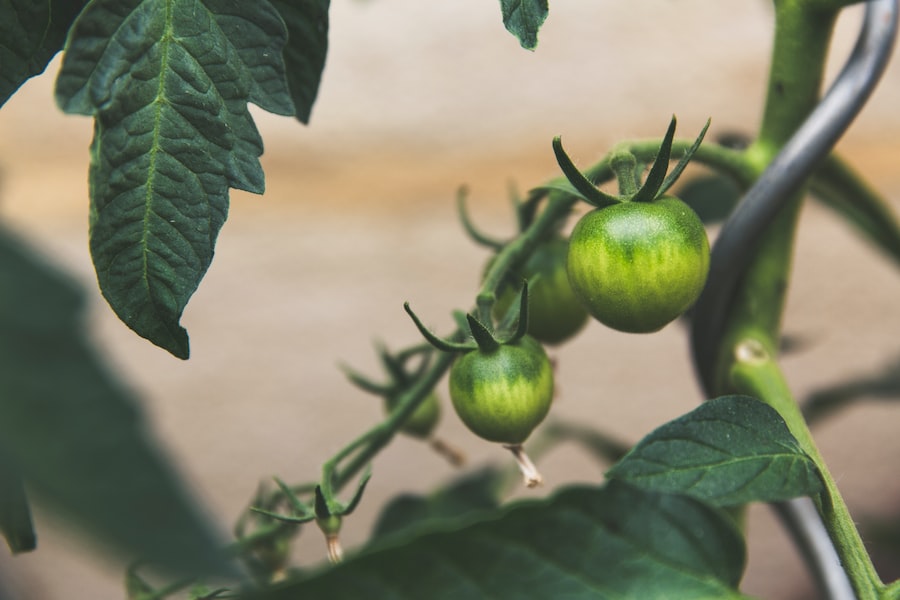From Seed to Fruit: A Guide to Growing Your Own Pomegranate Tree

Pomegranate trees have a rich history and are believed to have originated in the region of modern-day Iran and Iraq. They have been cultivated for thousands of years and are mentioned in ancient texts and mythology. The pomegranate tree is known for its beautiful, vibrant flowers and delicious, nutrient-rich fruits.
There are many benefits to growing pomegranate trees in your garden. Firstly, they are relatively easy to grow and require minimal maintenance. They are also highly adaptable and can thrive in a variety of climates, making them suitable for many regions around the world. Additionally, pomegranate trees are known for their ornamental value, with their attractive foliage and vibrant flowers adding beauty to any garden.
Furthermore, pomegranate fruits are packed with antioxidants, vitamins, and minerals, making them a healthy addition to your diet. They are known for their high levels of vitamin C and potassium, as well as their anti-inflammatory properties. Incorporating pomegranate fruits into your meals or enjoying them as a snack can provide numerous health benefits.
Key Takeaways
- Pomegranate trees are a great addition to any garden, offering beautiful flowers and delicious fruits.
- Choosing the right variety for your climate and space is crucial for successful growth and fruit production.
- Preparing the soil with proper drainage and nutrients is important for healthy tree growth.
- Planting and caring for your pomegranate tree involves regular watering, fertilizing, pruning, and pest control.
- Harvesting and storing your pomegranate fruits properly will ensure the best flavor and longevity.
Choosing the Right Pomegranate Variety for Your Garden
When choosing a pomegranate variety for your garden, there are several factors to consider. Firstly, you need to determine the climate in your region and choose a variety that is suitable for that climate. Pomegranate trees can tolerate a wide range of temperatures, but some varieties are more cold-hardy than others.
Another factor to consider is the size of the tree. Pomegranate trees can range in size from dwarf varieties that grow only a few feet tall to larger varieties that can reach up to 20 feet in height. Consider the available space in your garden and choose a variety that fits well.
Popular pomegranate varieties include ‘Wonderful’, ‘Grenada’, ‘Ambrosia’, and ‘Eversweet’. ‘Wonderful’ is one of the most widely grown varieties and is known for its large, sweet-tart fruits. ‘Grenada’ is a cold-hardy variety that produces medium-sized fruits with a deep red color. ‘Ambrosia’ is a newer variety that produces large, sweet fruits with a pinkish-red color. ‘Eversweet’ is a dwarf variety that is perfect for small gardens or container growing.
Preparing the Soil for Planting Pomegranate Trees
Pomegranate trees prefer well-draining soil that is slightly acidic to neutral in pH. Before planting, it is important to prepare the soil to ensure optimal growth and fruit production.
Start by testing the soil pH using a soil testing kit. If the pH is too high, you can lower it by adding elemental sulfur or peat moss. If the pH is too low, you can raise it by adding lime or wood ash.
Next, remove any weeds or grass from the planting area and loosen the soil with a garden fork or tiller. Pomegranate trees prefer loose, well-aerated soil, so it is important to break up any compacted areas.
Finally, amend the soil with organic matter such as compost or well-rotted manure. This will improve the soil structure and provide essential nutrients for the tree.
Planting Pomegranate Trees: Step-by-Step Guide
| Step | Description |
|---|---|
| 1 | Choose a sunny location with well-draining soil |
| 2 | Dig a hole twice as wide and deep as the root ball |
| 3 | Mix compost or aged manure with the soil |
| 4 | Place the tree in the hole and backfill with soil |
| 5 | Water thoroughly and add a layer of mulch |
| 6 | Prune the tree to remove any damaged or crossing branches |
| 7 | Fertilize in the spring and summer with a balanced fertilizer |
| 8 | Harvest the fruit when it is fully ripe and the skin is a deep red color |
The best time to plant pomegranate trees is in early spring when the soil has warmed up and there is no longer a risk of frost. Follow these steps to plant your pomegranate tree:
1. Dig a hole that is twice as wide and deep as the root ball of the tree.
2. Place the tree in the hole, making sure that the bud union (the swollen area where the tree was grafted onto the rootstock) is level with or slightly above the soil surface.
3. Backfill the hole with soil, firming it gently around the roots.
4. Water the tree thoroughly to settle the soil and eliminate any air pockets.
5. Mulch around the base of the tree with a layer of organic mulch, such as wood chips or straw, to conserve moisture and suppress weeds.
Watering and Fertilizing Your Pomegranate Tree
Pomegranate trees have moderate water requirements and should be watered deeply but infrequently. They prefer to be kept slightly on the dry side rather than constantly wet.
During the first year after planting, water the tree once or twice a week, providing enough water to moisten the soil to a depth of 6-8 inches. In subsequent years, water the tree every 10-14 days during dry periods.
Fertilize your pomegranate tree in early spring before new growth begins. Use a balanced fertilizer with equal amounts of nitrogen, phosphorus, and potassium. Apply the fertilizer according to the package instructions, taking care not to over-fertilize as this can lead to excessive vegetative growth at the expense of fruit production.
Pruning and Training Your Pomegranate Tree

Pruning is an important part of maintaining a healthy and productive pomegranate tree. It helps to shape the tree, promote airflow, and remove dead or diseased wood.
Pruning should be done in late winter or early spring before new growth begins. Start by removing any dead or damaged branches. Then, thin out any crowded areas to improve airflow and reduce the risk of disease.
To train your pomegranate tree into a desired shape, select 3-4 strong branches that are evenly spaced around the trunk and remove any competing branches. These main branches will form the framework of the tree.
Controlling Pests and Diseases in Pomegranate Trees
Pomegranate trees are generally resistant to pests and diseases, but there are a few common issues to watch out for.
Aphids can occasionally infest pomegranate trees, sucking sap from the leaves and causing them to curl. They can be controlled by spraying the tree with a strong jet of water or by using insecticidal soap.
Fungal diseases such as powdery mildew and root rot can also affect pomegranate trees. To prevent these diseases, avoid overwatering and ensure good airflow around the tree. If necessary, apply a fungicide according to the package instructions.
Harvesting Pomegranate Fruits: When and How to Do It
Pomegranate fruits are ready to harvest when they have reached their full color and have a slightly soft feel. The exact timing will depend on the variety and growing conditions.
To harvest the fruits, use a pair of pruning shears or scissors to cut them from the tree, leaving a short stem attached. Be careful not to damage the fruit or the surrounding branches.
Storing and Using Pomegranate Fruits: Tips and Tricks
Pomegranate fruits can be stored for several weeks if handled properly. Store them in a cool, dry place away from direct sunlight. They can also be refrigerated for longer storage.
To extract the seeds from the fruit, cut off the crown end of the fruit and make shallow cuts along the ridges from top to bottom. Hold the fruit over a bowl of water and gently break it apart into sections. Use your fingers to separate the seeds from the pith, allowing them to fall into the water. The seeds will sink to the bottom while the pith will float to the top. Skim off the pith and drain the seeds before using them.
Pomegranate seeds can be used in a variety of ways in cooking and drinks. They can be sprinkled over salads, added to smoothies, or used as a topping for desserts. They can also be juiced to make a refreshing and nutritious drink.
Enjoying the Fruits of Your Labor
Growing pomegranate trees in your garden can be a rewarding experience. Not only do they add beauty to your landscape, but they also provide delicious and nutritious fruits. By choosing the right variety, preparing the soil, and providing proper care, you can enjoy a bountiful harvest of pomegranates year after year. So why not give it a try and start enjoying the fruits of your labor?
If you’re interested in learning how to grow a pomegranate from seed, you’ll definitely want to check out this informative article from Lawn World. They provide step-by-step instructions and valuable tips on successfully growing your own pomegranate tree from seed. Whether you’re a seasoned gardener or a beginner, this article is a must-read for anyone looking to embark on this rewarding gardening journey. To access the article, click here.



